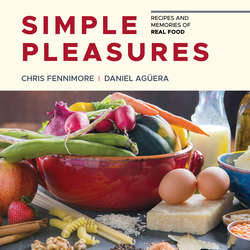Читать книгу Simple Pleasures - Chris Fennimore - Страница 10
На сайте Литреса книга снята с продажи.
ОглавлениеSIMPLE TOOLS
There is a modern myth that presumes you need a special tool in order to be successful in the kitchen. Our counters and drawers are cluttered with spiralizers, frothers, choppers, poachers, separators and “magic pots.” There is an entire industry devoted to kitchen gadgets.
Chris – I will confess to my own cluttered collection of peelers, scoops and spatulas and I couldn’t get by without my stand mixer, food processor and stick blender. But there are several tools that have stood the test of time and fit well into the concept of simple cooking. Chef Daniel and I have assembled a short list:
BENCH SCRAPER
Chris – This rectangular square of metal may get the most use of any utensil in my kitchen’s “junk” drawer. I use it to work dough on my wooden kneading board, portion out dough for loaves or rolls – even to rough chop vegetables and herbs and to smash garlic cloves.
CAST IRON SKILLETS
How do we love them? Let us count the ways: Inexpensive, indestructible, best pans for heat retention and distribution, non-stick and impervious to metal utensils.
CHINA CAP
The mesh is so fine on the china cap that you can use it in place of cheesecloth to strain the moisture from homemade cheese. It also gives a beautiful clear broth when you use it to strain your chicken stock. Think strainer on steroids.
FOLEY FOOD MILL
The genius of the food mill lies in its ability to simultaneously puree cooked foods and vegetables and to separate skins, seeds and stems from the finished product.
Chris – It’s my favorite for Sunday Sauce and Applesauce.
MICROPLANE
Say goodbye to the scraped knuckles from grating cheese on a box grater. Based on the woodworker’s rasp, microplanes come in a wide variety of sizes for everything from shredding mozzarella to finely grating nutmeg.
MORTAR AND PESTLE
With the advent of home food processors, it may seem as though the need for this primitive looking kitchen device has diminished. But there is something satisfying about grinding your own spices to the exact texture and consistency you like for your recipes.
Daniel – At home, my grandmother had a small wooden mortar and pestle with garlic and sea salt in it at all times. A little smash, a little rub, and the freshest garlic salt was ready.
The mortar and pestle is so universal in Spanish kitchens that its absence in U.S. kitchens surprised me. Here and there, you’ll find cooks like Chris or my friend Marla who keep a mortar and pestle handy. You should try using them, too. Nothing extracts the oils and flavors of herbs and citrus like a good smashing with the pestle! That fresh aroma takes over your kitchen and leads you on the journey to a great dish.
PARCHMENT PAPER
This simple tool makes us feel like wizards in the kitchen when the stickiest of cookies literally slide off the parchment. It’s also useful for a variety of other kitchen uses like making little pouches to cook fish and vegetables.
RICER
There is no other way to achieve light and fluffy mashed potatoes. It is also the perfect tool for extracting moisture from cooked spinach, grated potatoes, etc.
THERMOMETER
Why guess when you can know exactly when your food is done, or safe? Instant-read thermometers now register temperatures all the way from freezing to boiling sugar for candy making.
WOODEN SPOONS
Aside from being things of beauty that connect us with all our cooking ancestors, wooden spoons are usually the best tool for the job – mixing, stirring, folding. And the handles don’t get hot when you leave the spoon in the pot.
Daniel – For various reasons, wooden spoons aren’t often used in restaurants anymore. Before they were banned, a wooden spoon was like a maestro’s conducting baton in the hands of a chef, including my grandmother. Chefs would use them to point, gesture for emphasis, or even threaten. My grandmother delivered a few well-deserved smacks with a wooden spoon. The memories of her shaking that spoon in the air will forever be dear to me. From time to time, I see a nice piece of wood and think, “That would make a good wooden spoon.” I have quite a stash of these pieces of wood by now. One of these days when I have plenty of spare time I may carve some spoons again as I did when I was a kid.
TEMPERATURE CONVERSION CHART
The cooking temperatures given in the book are shown in Fahrenheit (°F). For our readers using metric, here are the Celsius (°C) equivalents for the temperatures you’ll encounter:
| FAHRENHEIT | CELSIUS |
| 115 | 46.1 |
| 160 | 71.1 |
| 165 | 74 |
| 200 | 93.3 |
| 275 | 135 |
| 300 | 148.9 |
| 350 | 176.7 |
| 365 | 185 |
| 375 | 190.5 |
| 400 | 204.4 |
| 425 | 218.3 |
| 450 | 232.2 |
| 475 | 246.1 |
